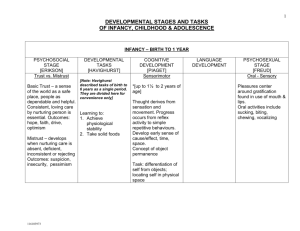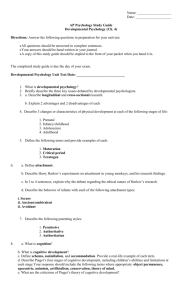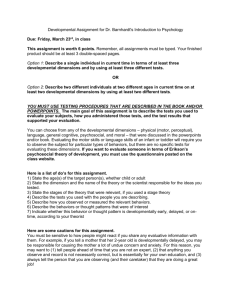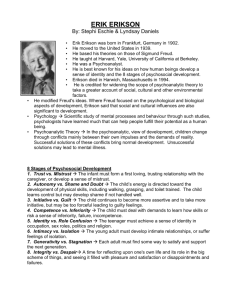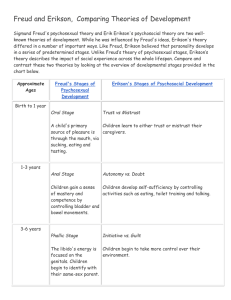Powerpoint #5 - Porterville College
advertisement
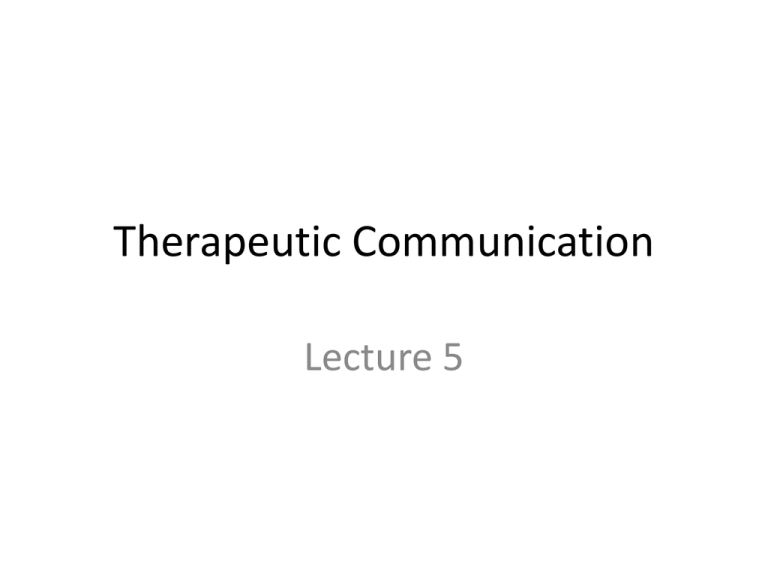
Therapeutic Communication Lecture 5 Course Objective # 25 • List approaches and precautions to take with the following patient experiencing: • Potential for violence, Hallucinating, Delusional, With conflicting values, With incoherent speech, Manipulative, Crying, That are sexually inappropriate, Uncooperative or in denial, Depressed/apathetic, Suspicious, Hyperactive, Transference Special Approaches/Precautions • Brief encounters Violent Behavior • • • • Keep your distance Do not touch without approval Change the topic Suggest a “Time Out” Violent Behavior • Sit by the door – DO NOT BLOCK THE DOORWAY! • Do not go into a room alone • Leave temporarily – Be aware of self-injury potential • Call for assistance Hallucinations • False perceptions (sensory) • Does not have an external stimuli • Patients see, hear, taste things that are not really there Illusions • Has a real external stimuli, but the patient misinterprets the stimuli Delusions • False beliefs Hallucinations • 1st – Comment – Assess the content • Powerlessness • Hatred • Guilt • Loneliness Hallucinations • Do not focus on the hallucination – Activities &encounters • “Do Not to act on commands” • “Tell staff” Bryan is a nurse assigned in a psychiatric ward; he takes note that the most common type of hallucination is: A. Visual B. Olfactory C. Auditory D. Tactile Delusions • A fixed, false belief • not consistent with the person’s intelligence and culture • unamenable to reason Delusions • 1st – Clarify the meaning – Rarely discussed • Do not arguing • Monitoring Conflicting Values • Nurses vs. patients • Examine the effects of beliefs • Perspective Incoherent Speech • Clarify • Repeated questions anxiety • Frequent, brief support Manipulation • Means to gain attention, sympathy, control & dependence • 1st – Address – Limit-setting – Help pts. to directly express their needs Crying • Allowed & encouraged –Nrs – quite • Stopped –Offer opportunity to talk Crying • “you seem ready to cry.” • “You still are upset about your brother’s death?” • “What are you think right now?” • Offer a tissue Sexual Innuendos or Inappropriate Touch • Correct • Discuss • If continue – Limit-setting – Reassignments Lack of Cooperation/Denial • ID the cause –Disturbances in thought process –Lack of insight –Disagreement –Fear Lack of Cooperation/Denial • Discussed directly • Trust • Patience Depressed Affect/Apathy • Acknowledge feelings but discourage rumination • Encourage – personal care • Postpone major decisions Depressed Affect/Apathy • Patience • Frequent contact • Empathy Suspiciousness • Underlying – Fear • Communicate – Clearly & simple – Avoid arguments – Rational • Encourage participation – Do not force Hyperactivity • • • • Decrease stimulation Physical activity Remain calm PRN meds? Terry with mania is skipping up and down the hallway practically running into other clients. Which of the following activities would the nurse in charge expect to include in Terry’s plan of care? A. Watching TV B. Cleaning dayroom tables C. Leading group activity D. Reading a book CLIENT SHIFTS THE FOCUS OF THE INTERVIER TO THE NURSE AND OFF OF THEMSELVES: • Client: “Do you have any children? Are you married?” • Nurse: “This time is for you.” • Nurse: “Do you have any children?” Client tries to get the nurse to take care of them. • Client: “Could you tell my doctor…” • Nurse: “I’ll leave a message with the clerk that you want to see him.” • “You know best what you want to say to him. I’ll be interested in what he has to say.” Object #11 • Compare and contrast the different theories of communication Psychoanalytical Theory • Father: –Sigmund Freud • 3 part theory 1. Levels of awareness 2. Components of the personality/mind 3. Psychosexual stages Freud’s levels of awareness • Conscious • Sub-conscious • Unconscious Level of awareness: Conscious • Immediate awareness –Reality –logic Level of awareness: Subconscious • AKA: Preconscious • Stores memories, thoughts, feelings • recalled with little effort Level of awareness: Unconscious • “Closed” to awareness • Painful memories –Stress Psychoanalytical Theory • Father: –Sigmund Freud • 3 part theory 1. Levels of awareness 2. Components of the personality/mind 3. Psychosexual stages 3 Components of the mind • Id • Ego • Superego Component of the Mind: • Primitive urges –Pleasure –Libido –Immediate Id Component of the Mind: SuperEgo • Judges, controls, punishes –Right from wrong –Conscience Component of the Mind: SuperEgo • Judges, controls, punishes –Right from wrong –Conscience Component of the Mind: SuperEgo • Judges, controls, punishes –Right from wrong –Conscience Component of the Mind: SuperEgo • Judges, controls, punishes –Right from wrong –Conscience Component of the Mind: Ego • Executive • Compromise • “Well, maybe later” Defense Mechanisms • AKA: Mental mechanisms –Coping Mechanisms • Protect the EGO –Adaptive –Maladaptive Defense Mechanism: Suppression • Putting it out of your awareness Defense Mechanism: Denial • AKA: Repression • Unable to recognize the event Defense Mechanism: Rationalization • Justify or excuse undesirable action or feelings Defense Mechanism: Identification • Take on the personality traits of another Defense Mechanism: Sublimation • Redirect impulses into acceptable outlets Defense Mechanism: Regression • Conflict • return to an earlier stage Defense Mechanism: Displacement • Transfer emotions from person to object Defense Mechanism: Projection • “Blaming mechanism” • Rejects unacceptable thoughts or feelings and attribute them to another person Defense Mechanism: Compensation • Make up for deficiencies in one area by excelling in another are Defense Mechanism: Undoing • Attempt to make-up for something unacceptable Defense Mechanism: Reaction formation • Overcompensation • Unacceptable feelings or thoughts are replaced with opposite feelings or thoughts Defense Mechanism: Conversion • Unconscious anxiety converts into physical symptoms (no organic basis) Defense Mechanism: Acting Out • Extreme behavior in order to express thoughts or feelings Psychoanalytical Theory • Father: –Sigmund Freud • 3 part theory 1. Levels of awareness 2. Components of the personality/mind 3. Psychosexual stages Freud’s 5 Stages of Psychosexual Development 1. Oral 2. Anal 3. Phallic 4. Latency 5. Genital • Conflict • Resolve • Next stage Oral Stage • Age – Birth – 18 months • Erogenous area – Mouth • Developmental task – Weaning – See self as separate from environment Oral Stage • Fixation – Dependency – Aggression – Seek oral stimulation Anal Stage • Age: – 18 months – 3 years • Erogenous area: – Anus • Developmental task: – Learning independence and control – Toilet training Anal Stage • Fixation: –Anal-expulsive • Messy, wasteful, destructive –Anal-retentive • Stringent, orderly, rigid Phallic Stage • Age –3 – 6 years • Erogenous area –Genital organs • Developmental task –ID with parent of the same gender Phallic Stage • Oedipus complex – Boys sexual attraction to mom • Electra complex – Girl attracted to dad Latency stage • Age – 6-12 years • Erogenous area – Dormant • Developmental task – Peer relationships Genital Stage • Age – 13-20 years • Erogenous area – Genital – Puberty • Developmental task – Relationships with opposite sex – Balance Psychoanalytical Theory • Father: – Sigmund Freud • 3 part theory 1. Levels of awareness 2. Components of the personality/mind 3. Psychosexual stages Summary: Freud • Personality determined by childhood events • Psychosexual stages – Incomplete stage – Fixation – Adult personality Psychosocial Theory • Erik Erikson • 8 stages span lifespan • Tasks have to be accomplished – h Independence – h Self-esteem Erikson’s Psychosocial Theory Trust Vs. Mistrust • Age – Birth – 18 mo. – Infancy • Major developmental Task – Develop trust with mothering figure and generalize it to others • Major Question: – "Can I trust the people around me?“ • Basic Virtue: – Hope • Important Event: – Feeding Erikson’s Psychosocial Theory Autonomy Vs. Shame & Doubt • Age – 18 mo – 3 yrs – Early Childhood • Major developmental Task – Gain some control & independence within the environment • Major Question: – "Can I do things myself or am I reliant on the help of others?" • Basic Virtue: – Will • Important Event: – Toilet Training Erikson’s Psychosocial Theory Initiative Vs. Guilt • Age – 3-6 yrs – Late childhood • Major developmental Task – Develop sense of purpose & the ability to initiate and direct own activities • Major Question: – “Am I good or bad?” • Basic Virtue: Purpose • Important Event: – Exploration, Play Erikson’s Psychosocial Theory Industry Vs. Inferiority • Age – 6 – 12 yrs – School age • Major developmental Task – Develop self-confidence by learning, competing etc. • Major Question: – "How can I be good?“ • Basic Virtue: – Competence • Important Event: – School Erikson’s Psychosocial Theory Identity Vs. Role Confusion • Age – 12 – 20 yrs – Adolescence • Major developmental Task – Integrate tasks mastered & secure sense of self • Major Question: – "Who am I?“ • Basic Virtue: – Fidelity • Important Event: – Social Relationships Erikson’s Psychosocial Theory Intimacy Vs. Isolation • Age – 20 – 30 – Young adulthood • Major developmental Task – Form intense lasting relationship • Major Question: – "Will I be loved or will I be alone?“ • Basic Virtue: – Love • Important Event: – Romantic Relationships Erikson’s Psychosocial Theory Generativity Vs. Stagnation • Age – 30 – 65 yrs – Adulthood • Major developmental Task – Achieve life goals and also considering the welfare of future generations • Major Question: – "How can I contribute to the world?“ • Basic Virtue: – Care • Important Event: – Parenthood & Work Erikson’s Psychosocial Theory Ego Integrity Vs. Despair • Age – 65 yrs – death – Old age • Major developmental Task – To review one’s life and derive meaning • Major Question: – "Did I live a meaningful life?“ • Basic Virtue: – Wisdom • Important Event: – Reflecting back on life Cognitive Theory • Jean Piaget • Intellect & develop thought processes Piaget’s Stages of Cognitive Development SENSORIMOTOR • Age – Birth – 2 yrs • Major developmental Task – – – – Mobility Sense of self Object permanence Form mental images Piaget’s Stages of Cognitive Development Preoperational • Age – 2 – 6 yrs • Major developmental Task – Express self with language – Understanding gestures – Object permanence Piaget’s Stages of Cognitive Development Concrete operational • Age – 6 - 12 yrs • Major developmental Task – – – – – Logical thinking Reversibility & spatiality Differentiate and classify Socializing Apply rules Piaget’s Stages of Cognitive Development Formal operational • Age – 12 – 16 yrs • Major developmental Task – – – – Abstract thinking Testing hypotheses Logical thinking Cogitative maturity Physiological Needs • O2 • Food • Water Safety Needs • Feeling free from danger and risk • Secure in one’s own environment Belonging • Feeling worthy of affection and social support Self-Esteem • Feeling competent • Strong self-worth Self-Actualization • Meeting one’s full potential Theory of Moral Development • Lawrence Kohlberg • Develop moral reasoning as you gain ability to think logically • 3 levels of moral development • 6 stages of acquired moral reasoning Kohlberg Dilemma • In Europe, a woman was near death from a special kind of cancer. There was one drug that the doctors thought might save her. It was a form of radium that a druggist in the same town had recently discovered. The drug was expensive to make, but the druggist was charging ten times what the drug cost him to make. He paid $200 for the radium and charged $2,000 for a small dose of the drug. The sick woman's husband, Heinz, went to everyone he knew to borrow the money, but he could only get together about $1,000 which is half of what it cost. He told the druggist that his wife was dying and asked him to sell it cheaper or let him pay later. But the druggist said: "No, I discovered the drug and I'm going to make money from it." So Heinz got desperate and broke into the man's store to steal the drug-for his wife. Should the husband have done that? Level: Preconventional • Age 4-10 yrs • Stage 1. Punishment & obedience oriented 2. Instrumental relativist oriented • Behavior motivated by fear of punishment • Behavior motivated by egocentrism and concern for self Level: Conventional • Age: 10-13 yrs • Stage 3. Interpersonal concordance orientation 4. Law and order orientation • Behavior motivated by expectations of others, strong desire for approval & acceptance • Behavior motivated by respect for authority Level: Postconventional • Age: adolescence up • Stages 5. Social contract legalistic orientation 6. Universal ethical principle orientation • Behavior motivated by respect for laws and moral principles • Behavior motivated by internalized principles of honor
